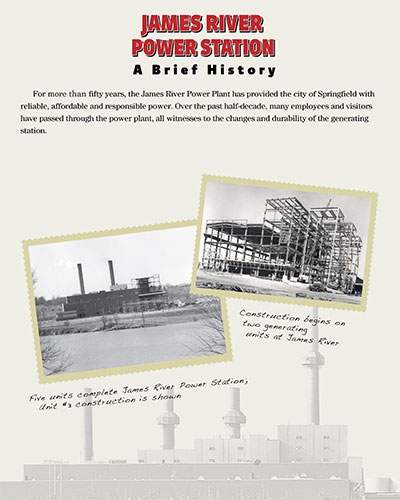History
The Lake and Park

Lake Springfield was originally designed in 1957 by City Utilities to support the James River Power Station. The lake was created by damming the James River to serve the power station’s cooling needs. In the early 1990s, the Missouri Department of Conservation partnered with CU to construct a boat ramp, fishing dock and several fishing platforms at Clay Henshaw Memorial and Southwood accesses. Lake Springfield Park and Boathouse are part of the Springfield-Greene County Park System due to a long-term lease with CU. Access to water-based activities predominantly take place from the park. Today, the lake provides opportunities for boating, fishing and water sports in addition to park activities such as picnicking, walking and biking the Ozark Greenway trails through the park and enjoying the scenic views.
The Power Station

Springfield would not be where it is today without the James River Power Station (JRPS). While serving as a reliable, locally generated source of electricity, JRPS helped establish Springfield, in both population and prominence, thereby forever changing southwest Missouri. James River Power Station was officially decommissioned on Jan. 28, 2021, after more than 63 years of service to the community. The implosion of the power station’s four flue-exhaust stacks took place Feb. 19, 2022.
Eager to control their own power generation needs, community members began discussions to build a power station in the early 1940s. After two failed ballot measures, the community finally approved the proposal by a wide margin to build JPRS in 1954. By 1957, the building, Lake Springfield dam roadway, and two units were built with a price tag of $11 million. By 1970, all five units were up and running, which kick-started an era of growth for the area. Springfield’s population was 67,000 in 1957 and nearly doubled by 1970. The reliable generation source provided the foundation for economic and industrial development for the region.
Originally built to use natural gas as fuel, JRPS transitioned to burn coal in the late 1970s in response to the nation’s energy crisis. The plant transitioned back to natural gas in 2015.
While this chapter has come to an end, JRPS leaves behind a legacy of excellence, while also laying the foundation of success for Springfield and generations to come.
Case Study: Harnessing opportunity to achieve big impact
As coal plants shutter around the country, the visioning at Lake Springfield joins a growing collection of such projects across the nation.
By tapping into an expanding array of state and federal subsidies, these projects seek to turn these types of structures and the often scenic land around them into potential assets for economic growth.
Learn about the site plan developed in Cleveland called Avon Lake that hopes to redevelop its 131 acres situated at the edge of Lake Erie.
More Information

